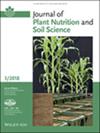Assignment of Thermogravimetric Mass Losses to Soil Organic Matter, Its Fractions Hot Water–Extractable and Microbial Biomass Carbon, and Organic Matter–Stabilizing Soil Mineral Properties
Abstract
Background
The stability of soil organic matter (SOM) can be characterized by thermal analysis. Methods to determine the thermal stability of SOM have recently been increasingly applied in soil analysis. Most studies focus on organic carbon (OC), whereas its subfractions, for example, microbial biomass carbon (MBC) or hot water–extractable carbon (HWEC), representing fast-reacting pools, have been less investigated.
Aim
A set of 100 soil samples was analyzed for thermal mass losses and their relation to SOM and soil mineral phase properties.
Method
The temperature-dependent mass losses were determined by thermogravimetric analysis. For this purpose, soils differing in terms of parent material, soil texture, and land use were characterized and analyzed.
Results
Temperature ranges of mass losses and corresponding fractions of different thermal stability (thermolabile and thermostable) were defined. SOM-related parameters were highly correlated with mass losses of the thermolabile fractions. Mass losses of thermostable matter were significantly correlated with soil mineral phase parameters. The soil thermostability index (STSI) was calculated as the ratio of thermolabile and thermostable mass proportions, represented by the mass losses of selected temperature intervals. Regressions of STSI with ratios of mineral phase parameters to OC (e.g., clay/OC), representing the saturation degree of the mineral phase with OC, HWEC, or MBC, yielded strong relationships.
Conclusion
The saturation of the mineral phase with OC determines the thermal stability of OC. Overall, relevant factors for OC thermal stability were identified. OC and HWEC were significantly correlated with thermal stability and mineral phase saturation. For MBC, no such relationship was found, indicating that its stability is driven by other factors.


 求助内容:
求助内容: 应助结果提醒方式:
应助结果提醒方式:


